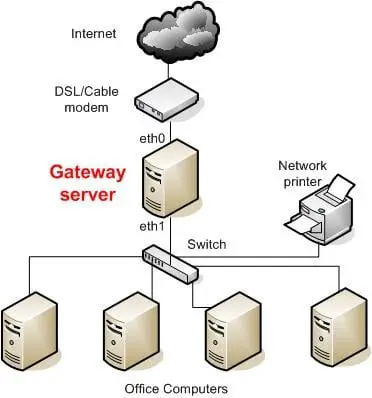The term ‘gateway’ in the networking world is a chameleon, representing a plethora of roles and functions, each critical to the flow of digital communication. But what exactly does ‘gateway’ signify in different contexts? From facilitating email transmission in one form to acting as a default pathway in another, the term encompasses a broad spectrum of functionalities. In this article, we will embark on a journey through the various incarnations of network gateways, shedding light on their indispensable roles in our interconnected world.
Have you ever wondered how an email morphs from one format to another or how your computer knows where to send data outside your local network? These questions and more find their answers in the world of gateways. We’ll dissect these vital components of networking, understanding their operations and significance in diverse scenarios.
Table of Contents:
- What is Gateway in Networking?
- Email Gateways
- Default Gateways in IP Networking
- SNA-TCP/IP Gateways
- Gateways in LAN and Packet-Switching Networks
- Modern Applications of Gateways
- Conclusion
- References

1. What is Gateway in Networking?
In the realm of computer networking, a gateway is a hardware device or software program that acts as a bridge between two different networks, often using different protocols. It serves as a critical point of access, enabling data to flow between disparate networks. This functionality is not just limited to routing data; gateways also translate the different protocols that each network uses, ensuring compatibility and seamless communication.
Gateways operate at the higher levels of the OSI model, typically at the application layer, which allows them to interpret, translate, and route data more effectively than devices operating at lower levels, like switches and routers. By functioning at these higher levels, gateways can provide more complex services such as protocol conversions, data formatting, and security functions.

Overview of Different Types
Network gateways come in various forms, each serving a unique purpose:
- Email Gateways: These specialize in managing and routing email traffic, often performing conversions between different email protocols.
- Default Gateways: Common in IP networking, they serve as an exit point for a network to send out data to different networks, typically the internet.
- SNA-TCP/IP Gateways: These bridge IBM’s Systems Network Architecture (SNA) with TCP/IP networks, facilitating communication between these distinct systems.
- Packet-Switching Network Gateways: Such as a Packet Assembler/Disassembler (PAD), they connect LANs to X.25 networks or other types of packet-switched networks.
Each type of gateway plays a unique role in ensuring efficient and effective communication across diverse network environments.
2. Email Gateways
Role in Email Transmission
Email gateways are crucial in the transmission and management of email traffic within and between different email systems. They act as intermediaries that receive, process, and deliver emails, ensuring that the messages are correctly routed to their destinations. In addition to basic routing, email gateways often handle tasks such as filtering spam, scanning for viruses, and enforcing email policies.
A significant function of email gateways is protocol translation. Email systems use various protocols, such as SMTP (Simple Mail Transfer Protocol) for sending emails and IMAP/POP for retrieving them. The gateway ensures that these protocols are correctly interpreted and applied, enabling smooth email communication across different systems and networks.
Case Study: SMTP to X.400 Translation
A classic example of an email gateway’s role is the translation of SMTP email into the X.400 format. SMTP is widely used for sending email over the Internet, while X.400 is often used in internal corporate email systems and offers different features and formatting.
In this scenario, the email gateway receives an SMTP email, interprets the content and headers, and then translates this into the X.400 format. This process involves converting address formats, message formats, and potentially content encoding schemes. The gateway ensures that the email, once converted, is correctly understood and processed in the X.400 system, maintaining the integrity and intent of the original message. This capability is vital for organizations that operate multiple email systems or connect with external networks, ensuring seamless communication across different email protocols.
3. Default Gateways in IP Networking
Understanding the Concept
A default gateway in IP networking is a crucial component that allows devices on one network to communicate with devices on another network. Typically, this is the mechanism through which a local network connects to the internet. In a local area network (LAN), the default gateway often corresponds to a router or a similar device that acts as an intermediary between the internal network and external networks.
Each device on the network is configured with the IP address of the default gateway, enabling it to send data to destinations outside the local network. When a device needs to communicate with an external IP address, it sends the data to the default gateway, which then routes the data to the intended destination.
Configuration and Importance in Data Routing
Configuring a default gateway is a straightforward process. It involves setting the IP address of the gateway on each device’s network settings. In a typical home or small office network, the default gateway’s IP address is assigned to the router provided by the internet service provider (ISP).
The importance of a properly configured default gateway in data routing cannot be overstated. Without it, devices on a local network would be unable to access or communicate with external networks, effectively isolating them. The default gateway serves as the essential bridge to the wider internet, routing outbound data to the appropriate external network and directing inbound data from the internet to the correct device on the local network.
4. SNA-TCP/IP Gateways
Bridging IBM’s SNA and TCP/IP Networks
Systems Network Architecture (SNA) is a proprietary networking architecture developed by IBM, primarily used for mainframe environments. In contrast, TCP/IP is the standard suite of communication protocols used for the Internet and most modern networks. SNA-TCP/IP gateways are specialized network devices or software solutions that bridge these two vastly different architectures, allowing them to communicate with each other.
These gateways translate the networking protocols from SNA to TCP/IP and vice versa, enabling seamless data exchange between SNA mainframes and TCP/IP networks. This translation includes adapting the different addressing schemes, packet formats, and communication protocols used by each system.
Example: Microsoft SNA Server
Microsoft SNA Server is an example of an SNA-TCP/IP gateway. It enables computers running on a TCP/IP network, such as those with Windows operating systems, to access and use resources available on an SNA network. This access can include mainframe applications, data, and printers.
The SNA Server software acts as an intermediary, receiving TCP/IP requests from client machines, translating them into SNA commands, and forwarding them to the mainframe. Conversely, it receives SNA responses from the mainframe, translates them into TCP/IP format, and sends them back to the client machines.
This capability is critical for organizations that rely on legacy mainframe systems but also want to leverage the flexibility and ubiquity of TCP/IP-based networks. By using an SNA-TCP/IP gateway like Microsoft SNA Server, these organizations can integrate their modern and legacy systems, ensuring smooth, uninterrupted operations and communication across their network infrastructure.
5. Gateways in LAN and Packet-Switching Networks
Connecting LANs to X.25 Networks
In the context of connecting Local Area Networks (LANs) to X.25 networks, gateways play a pivotal role. X.25, an early packet-switching network protocol, facilitates data communication over long distances, typically used by telecommunications providers. LANs, often employing protocols like Ethernet, require a mechanism to connect to these X.25 networks for wider communication.
Gateways in this scenario perform the critical task of translating the data formats and communication protocols from LAN-based standards to those compatible with X.25 networks. This includes handling differences in packet sizes, transmission speeds, and error-handling methods, ensuring that data can be transferred smoothly between these distinct network types.
Function of Packet Assembler/Disassembler (PAD)
A Packet Assembler/Disassembler (PAD) is a type of gateway specifically designed for connecting devices on a LAN to an X.25 network. The PAD assembles data from the LAN into packets suitable for transmission over the X.25 network and disassembles incoming X.25 packets into a format understandable by devices on the LAN.
This process involves buffering data to account for speed differences between the networks, error checking, and converting address formats. PADs are essential in environments where legacy X.25 networks are still in use, providing a bridge to modern LAN technologies.
6. Modern Applications of Gateways
Role in IoT and Cloud Computing
In the contemporary digital landscape, gateways have found new relevance in the realms of the Internet of Things (IoT) and cloud computing. IoT gateways bridge the gap between IoT devices, which often use various communication protocols and standards, and the larger internet or cloud-based systems. They aggregate data from multiple IoT devices, preprocess it, and then transmit it to cloud services for further analysis and storage.
In cloud computing, gateways facilitate secure and efficient data transfer between on-premises networks and cloud services. They manage the encryption and decryption of data, ensuring secure transmissions, and can also optimize data for cloud storage and processing, reducing bandwidth usage and improving overall efficiency.
Future Trends and Evolutions
The future of network gateways is closely tied to the evolution of networking technologies and protocols. As networks become faster, more complex, and more integrated with cloud services and IoT devices, gateways will evolve to handle higher data volumes, more diverse data types, and more sophisticated security threats.
Emerging technologies like edge computing, where data processing occurs closer to the source of data generation, will also influence the role of gateways. In this paradigm, gateways could become more intelligent, capable of performing significant data processing and decision-making at the network edge, reducing the need for constant cloud connectivity.
7. Conclusion
The exploration of network gateways reveals their indispensable role in the fabric of modern networking. From bridging traditional LANs with packet-switching networks to facilitating the latest IoT and cloud technologies, gateways have continuously adapted to meet the evolving needs of digital communication.
Understanding the diverse functionalities and applications of gateways is crucial for anyone involved in network design, management, or optimization, reflecting their continued importance in ensuring seamless, secure, and efficient network operations.
8. References
- “Computer Networking: A Top-Down Approach” by James Kurose and Keith Ross: Offers a comprehensive look at network fundamentals, including the role of gateways.
- “Data Communications and Networking” by Behrouz A. Forouzan: Provides insights into various network technologies and protocols, with a focus on gateway functionality.
- RFC 1356 – Multiprotocol Interconnect on X.25 and ISDN in the Packet Mode: Technical document detailing the integration of different protocols over X.25 networks.
- “Edge Computing: Vision and Challenges” by Satyanarayanan et al.: Presents an overview of edge computing and its implications for network gateways and data processing.
- IBM Redbooks on Systems Network Architecture (SNA): Provides detailed information on SNA networks and their integration with TCP/IP systems.